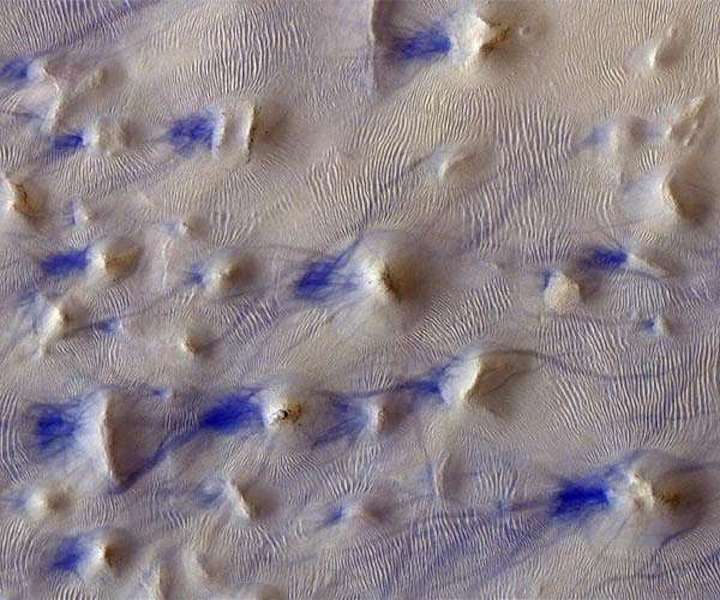16.02.2022

The bluish tinge to the dust devil tracks seen here is a result of the three filters that were combined to create this image; while not representative of what an observer would see with the naked eye, these filters produce a colour infrared image with greater sensitivity to variations in surface mineralogy.
Chaotic mounds, wind-sculpted ripples and dust devil tracks: this image shows a fascinating and otherworldly landscape near Hooke Crater in Mars' southern highlands.
The image was taken by the CaSSIS camera onboard the ESA/Roscosmos ExoMars Trace Gas Orbiter (TGO) on 1 February 2021, and shows part of Argyre Planitia, centred at 46.2 S/318.3 E.
This type of scenery is similar to 'chaotic terrain': a kind of broken, disrupted terrain seen across Mars where haphazard groups of variously sized and shaped rocks - irregular knobs, conical mounds, ridges, flat-topped hills known as mesas - clump together, often enclosed within depressions.
There are around 30 regions of chaotic terrain defined on Mars (see ESA Mars Express views of Ariadnes Colles, Pyrrhae Regio, and Iani Chaos for just a small sample); while this small patch has not been defined as one of these, its appearance is certainly chaotic.
Perhaps the most striking feature here is the wispy, snaking tendrils stretching out across the frame. These dark traces of past activity were caused by dust devils, whirlwinds of dust that occur on both Mars and Earth when warm air rises quickly into cooler air.
These devils leave tracks on a planet's surface as they travel through dusty landscapes. The tracks here appear to have a north-south orientation, indicating a possible local wind pattern.
The bluish tinge to the dust devil tracks seen here is a result of the three filters that were combined to create this image; while not representative of what an observer would see with the naked eye, these filters produce a colour infrared image with greater sensitivity to variations in surface mineralogy.
TGO arrived at Mars in 2016 and began its full science mission in 2018. The spacecraft is not only returning spectacular images like this one, but also providing the best ever inventory of the planet's atmospheric gases, and mapping the planet's surface for water-rich locations.
It will also provide data relay services for the second ExoMars mission, comprising the Rosalind Franklin rover and Kazachok platform, when it arrives on Mars in 2023.
Quelle: SD

